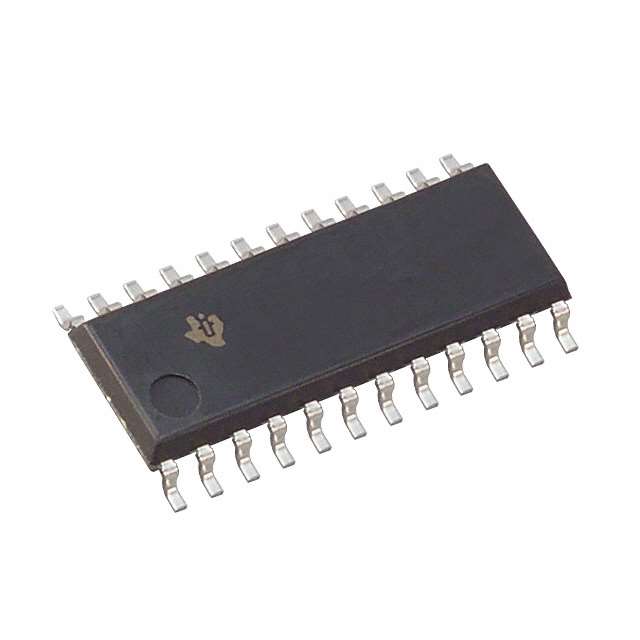SN74ABT543ANSR
Product Overview
- Category: Integrated Circuit (IC)
- Use: Bus Transceiver
- Characteristics: High-speed, Bi-directional, 8-bit transceiver
- Package: SOIC (Small Outline Integrated Circuit)
- Essence: Facilitates bidirectional data transfer between two buses with different voltage levels
- Packaging/Quantity: Tape and Reel, 2500 units per reel
Specifications
- Supply Voltage Range: 4.5V to 5.5V
- Logic Family: ABT
- Number of Channels: 8
- Input/Output Type: Tri-State
- Maximum Data Rate: 200 MHz
- Operating Temperature Range: -40°C to +85°C
Detailed Pin Configuration
The SN74ABT543ANSR has a total of 20 pins. The pin configuration is as follows:
- OE (Output Enable) 1
- A1 (Data Bus A) 1
- A2 (Data Bus A) 2
- A3 (Data Bus A) 3
- A4 (Data Bus A) 4
- A5 (Data Bus A) 5
- A6 (Data Bus A) 6
- A7 (Data Bus A) 7
- A8 (Data Bus A) 8
- GND (Ground)
- B8 (Data Bus B) 8
- B7 (Data Bus B) 7
- B6 (Data Bus B) 6
- B5 (Data Bus B) 5
- B4 (Data Bus B) 4
- B3 (Data Bus B) 3
- B2 (Data Bus B) 2
- B1 (Data Bus B) 1
- OE (Output Enable) 2
- VCC (Supply Voltage)
Functional Features
- Bi-directional data transfer between two buses with different voltage levels
- Tri-state outputs for bus isolation
- High-speed operation for efficient data transmission
- Output enable control for flexible data flow management
Advantages and Disadvantages
Advantages: - Enables seamless communication between buses operating at different voltage levels - Supports high-speed data transfer up to 200 MHz - Provides tri-state outputs for bus isolation and flexibility in data flow management
Disadvantages: - Limited to 8-bit data transfer, may not be suitable for applications requiring larger data widths - Requires careful consideration of voltage compatibility between the two buses
Working Principles
The SN74ABT543ANSR is a bidirectional bus transceiver that allows data transfer between two buses with different voltage levels. It operates by using a combination of input/output buffers and control logic. The output enable (OE) pins control the direction of data flow, enabling or disabling the transceiver's outputs.
When OE is low, the transceiver is enabled, and data can be transferred bidirectionally between the A and B buses. When OE is high, the outputs are disabled, effectively isolating the two buses.
The transceiver also features tri-state outputs, which allow the outputs to be put into a high-impedance state when not actively driving the bus. This feature enables multiple transceivers to be connected to the same bus without causing conflicts.
Detailed Application Field Plans
The SN74ABT543ANSR is commonly used in various applications where bidirectional data transfer between buses with different voltage levels is required. Some specific application fields include:
- Communication Systems: Facilitating data exchange between different modules operating at varying voltage levels.
- Industrial Automation: Enabling communication between control systems and peripheral devices with different voltage requirements.
- Automotive Electronics: Supporting data transfer between various vehicle subsystems operating at different voltages.
- Computer Systems: Facilitating communication between different components, such as memory modules and processors, with varying voltage levels.
Detailed and Complete Alternative Models
- SN74ABT543ADWR: SOIC package, 2500 units per reel, similar specifications.
- SN74ABT543ADBQR: SSOP package, 2000 units per reel, similar specifications.
- SN74ABT543APWRG4: TSSOP package, 3000 units per reel, similar specifications.
These alternative models offer similar functionality and characteristics to the SN74ABT543ANSR, providing options for different packaging preferences or quantity requirements.
Word count: 529 words
Lista 10 Vanliga frågor och svar relaterade till tillämpningen av SN74ABT543ANSR i tekniska lösningar
Sure! Here are 10 common questions and answers related to the application of SN74ABT543ANSR in technical solutions:
Q: What is SN74ABT543ANSR? A: SN74ABT543ANSR is a type of integrated circuit (IC) commonly used as an octal transceiver with 3-state outputs.
Q: What is the purpose of SN74ABT543ANSR? A: The purpose of SN74ABT543ANSR is to enable bidirectional data transfer between two buses with different voltage levels or signal types.
Q: What voltage levels does SN74ABT543ANSR support? A: SN74ABT543ANSR supports voltage levels ranging from 2.7V to 5.5V, making it compatible with a wide range of systems.
Q: How many data lines can SN74ABT543ANSR handle? A: SN74ABT543ANSR can handle up to 8 data lines, making it suitable for applications requiring multiple data transfers.
Q: Can SN74ABT543ANSR be used in both input and output modes? A: Yes, SN74ABT543ANSR can be used in both input and output modes, allowing bidirectional data flow.
Q: Does SN74ABT543ANSR have any built-in protection features? A: Yes, SN74ABT543ANSR has built-in ESD (electrostatic discharge) protection, which helps safeguard against damage during handling or operation.
Q: What is the maximum data transfer rate supported by SN74ABT543ANSR? A: SN74ABT543ANSR supports high-speed data transfer rates of up to 200 MHz, making it suitable for applications requiring fast communication.
Q: Can SN74ABT543ANSR be used in mixed-voltage systems? A: Yes, SN74ABT543ANSR is designed to handle mixed-voltage systems, allowing seamless integration between different voltage domains.
Q: Does SN74ABT543ANSR have any power-saving features? A: Yes, SN74ABT543ANSR incorporates a power-down mode that reduces power consumption when the device is not actively transferring data.
Q: What are some typical applications of SN74ABT543ANSR? A: SN74ABT543ANSR is commonly used in various technical solutions such as data communication systems, bus interfaces, memory modules, and industrial automation equipment.
Please note that these answers are general and may vary depending on specific design requirements and application scenarios.


